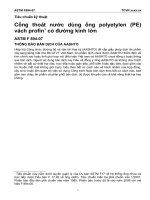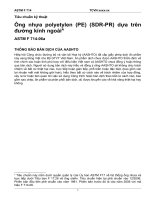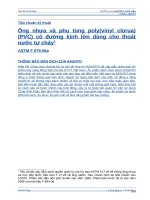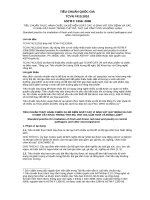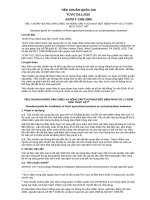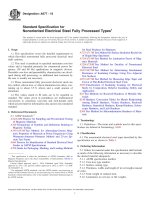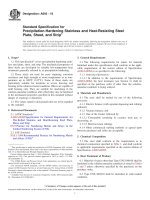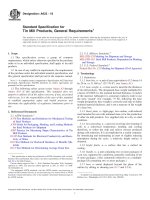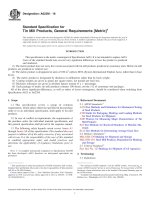Astm astm f 1058 16
Bạn đang xem bản rút gọn của tài liệu. Xem và tải ngay bản đầy đủ của tài liệu tại đây (105.67 KB, 5 trang )
This international standard was developed in accordance with internationally recognized principles on standardization established in the Decision on Principles for the
Development of International Standards, Guides and Recommendations issued by the World Trade Organization Technical Barriers to Trade (TBT) Committee.
Designation: F1058 − 16
Standard Specification for
Wrought 40Cobalt-20Chromium-16Iron-15Nickel7Molybdenum Alloy Wire, Strip, and Strip Bar for Surgical
Implant Applications (UNS R30003 and UNS R30008)1
This standard is issued under the fixed designation F1058; the number immediately following the designation indicates the year of
original adoption or, in the case of revision, the year of last revision. A number in parentheses indicates the year of last reapproval. A
superscript epsilon (´) indicates an editorial change since the last revision or reapproval.
1. Scope*
scope Hardness, and Leeb Hardness
E354 Test Methods for Chemical Analysis of HighTemperature, Electrical, Magnetic, and Other Similar Iron,
Nickel, and Cobalt Alloys
IEEE/ASTM SI 10 American National Standard for Metric
Practice
1.1 This specification covers the chemical, mechanical, and
metallurgical requirements for two grades of wrought
40cobalt-20chromium-16iron-15nickel-7molybdenum alloy in
the form of wire, strip and bar used for the manufacture of
surgical implants.
2.2 Aerospace Material Specifications:3
AMS 2269 Chemical Check Analysis Limits Wrought
Nickel and Alloys and Cobalt Alloys
AMS 5833 Alloy Wire, Corrosion and Heat Resistant 20Cr15Ni-40Co-7.0Mo-16Fe Solution Treated and Cold
Drawn
AMS 5834 Alloy Wire, Corrosion and Heat Resistant 20Cr15Ni-40Co-7.0Mo-16Fe Solution Heat Treated, Cold
Drawn, and Aged
AMS 5875 Alloy Strip, Corrosion and Heat Resistant 20Cr15Ni-40Co-7.0Mo-16Fe Solution Heat Treated, Cold
Rolled, and Aged
AMS 5876 Alloy Strip, Corrosion and Heat Resistant 20Cr15Ni-40Co-7.0Mo-16Fe Solution Heat Treated and Cold
Rolled
1.2 The values stated in either SI units or inch-pound units
are to be regarded separately as standard. The values stated in
each system may not be exact equivalents; therefore, each
system shall be used independently of the other. Combining
values from the two systems may result in non-conformance
with the standard.
2. Referenced Documents
2.1 ASTM Standards:2
A751 Test Methods, Practices, and Terminology for Chemical Analysis of Steel Products
E8/E8M Test Methods for Tension Testing of Metallic Materials
E18 Test Methods for Rockwell Hardness of Metallic Materials
E29 Practice for Using Significant Digits in Test Data to
Determine Conformance with Specifications
E45 Test Methods for Determining the Inclusion Content of
Steel
E92 Test Methods for Vickers Hardness and Knoop Hardness of Metallic Materials
E112 Test Methods for Determining Average Grain Size
E140 Hardness Conversion Tables for Metals Relationship
Among Brinell Hardness, Vickers Hardness, Rockwell
Hardness, Superficial Hardness, Knoop Hardness, Sclero-
2.3 ISO Standards:4
ISO 5832-7 Implants for Surgery—Metallic Materials—Part
7 Forgeable and Cold Formed Co-Cr-Ni-Mo-Fe Alloy
ISO 6892–1 Metallic materials—Tensile testing—Part 1:
Method of test at room temperature
ISO 9001 Quality Management Systems—Requirements
2.4 Society of Automotive Engineers:5
SAE J1086 Practice for Numbering Metals and Alloys
(UNS)
3. Terminology
3.1 Definitions of Terms Specific to This Standard:
1
This specification is under the jurisdiction of ASTM Committee F04 on
Medical and Surgical Materials and Devices and is the direct responsibility of
Subcommittee F04.12 on Metallurgical Materials.
Current edition approved Nov. 1, 2016. Published January 2017. Originally
approved in 1991. Last previous edition approved in 2008 as F1058 – 08. DOI:
10.1520/F1058-16.
2
For referenced ASTM standards, visit the ASTM website, www.astm.org, or
contact ASTM Customer Service at For Annual Book of ASTM
Standards volume information, refer to the standard’s Document Summary page on
the ASTM website.
3
Available from Society of Automotive Engineers (SAE), 400 Commonwealth
Dr., Warrendale, PA 15096-0001, .
4
Available from American National Standards Institute (ANSI), 25 W. 43rd St.,
4th Floor, New York, NY 10036, .
5
Available from SAE International (SAE), 400 Commonwealth Dr., Warrendale,
PA 15096, .
*A Summary of Changes section appears at the end of this standard
Copyright © ASTM International, 100 Barr Harbor Drive, PO Box C700, West Conshohocken, PA 19428-2959. United States
1
F1058 − 16
TABLE 1 Chemical Requirements, Heat Analysis
3.1.1 bar, n—round bars and flats from 4.75 to 101.60 mm
[0.1875 to 4.00 in.] in diameter or thickness (other shapes by
special order).
3.1.2 fine wire, n—wire as described in 3.1.5, less than 1.60
mm [0.063 in.] in diameter or thickness.
3.1.3 lot, n—the total number of mill products produced
from the same melt heat under the same conditions at essentially the same time.
3.1.4 strip, n—any product under 4.76 mm [0.188 in.] in
thickness and under 610 mm [24 in.] wide.
3.1.5 wire, n—rounds, flats or other shapes less than 4.76
mm [0.1875 in.] in diameter or thickness.
Composition, (% mass/mass)
Element
Carbon
Manganese
Silicon
Phosphorus
Sulfur
Cobalt
Chromium
Nickel
Molybdenum
Beryllium
IronA
Grade 1 (UNS R30003)
Grade 2 (UNS R30008)
min
max
min
max
...
1.5
...
...
...
39.0
19.0
14.0
6.0
...
Balance
0.15
2.5
1.20
0.015
0.015
41.0
21.0
16.0
8.0
0.001B
Balance
...
1.0
...
...
...
39.0
18.5
15.0
6.5
...
Balance
0.15
2.0
1.20
0.015
0.015
42.0
21.5
18.0
7.5
0.001
Balance
A
Approximately equal to the difference between 100 % and the sum percentage
of the other specified elements. The percentage iron content by difference is not
required to be reported.
B
Denotes more restrictive limit than UNS.
4. Ordering Information
4.1 Inquiries and orders for material under this specification
shall include the following information:
4.1.1 Quantity (weight or number of pieces);
4.1.2 ASTM designation, grade, and date of issue;
4.1.3 Form (wire, strip, or bar);
4.1.4 Applicable dimensions, including size, thickness,
width, and length (exact, random, multiples) and tolerances
where critical, and drawing number;
4.1.5 Condition;
4.1.6 Finish;
4.1.7 Mechanical properties, if applicable, for special conditions;
4.1.8 Special tests (if any); and
4.1.9 Other requirements (if applicable).
elements not listed in Table 1 is not required but is allowed to
verify compliance with this specification.
6.2.2 All commercial metals contain small amounts of
elements other than those which are specified. It is neither
practical nor necessary to specify limits for unspecified
elements, whether residual elements or trace elements, that can
be present. The producer is permitted to analyze for unspecified
elements and is permitted to report such analyses. The presence
of an unspecified element and the reporting of an analysis for
that element shall not be a basis for rejection.
6.3 Product Analysis The product analysis is either for the
purpose of verifying the composition of a heat or lot or to
determine variations in the composition within a heat.
6.3.1 Acceptance or rejection of a heat or lot of material
may be made by the purchaser on the basis of this product
analysis.
6.3.2 Product analysis tolerances do not broaden the specified heat analysis requirements, but cover variations between
laboratories in the measurement of chemical content. Product
analysis limits shall be as specified in Table 2.
5. Materials and Manufacture
5.1 Condition—Wire and strip shall be furnished to the
purchaser in the annealed, cold worked, or cold worked and
aged condition. Bars shall be furnished to the purchaser in the
cold worked or cold worked and aged condition.
5.2 Finish:
5.2.1 Types of finish available for wire are bright-annealed,
pickled, cold-drawn, ground, ground and polished, or as
specified in the purchase order.
5.2.2 Types of finish available for strip are bright-annealed,
pickled, cold-rolled, polished, or as specified in the purchase
order.
5.2.3 Types of finish available for bar are cold-drawn,
cold-drawn and aged, ground, ground and polished, or as
specified in the purchase order.
TABLE 2 Product Analysis TolerancesA
Element
Carbon
Manganese
Silicon
Phosphorous
Sulfur
Cobalt
Chromium
Nickel
Molybdenum
Beryllium,B
6. Chemical Requirements
6.1 Chemical analysis shall be in accordance with Test
Methods E354 and A751.
6.2 The 40cobalt-20chromium-16iron-15nickel-7molybdenum alloy heat analysis shall conform to the chemical
requirements of Grade 1 or 2 as specified in Table 1. The
supplier shall not ship material that is outside the limits
specified in Table 1 for the applicable grade.
6.2.1 Requirements for the major and minor elemental
constituents for Grade 1 and 2 of this alloy are listed in Table
1. Also listed are important residual elements. Analysis for
Tolerances over the max (upper limit) or
under the min (lower limit),
% mass/mass
Grade 1 (UNS
R30003)
Grade 2 (UNS
R30008)
0.01
0.04
0.10
0.005
0.003
0.50
0.25
0.20
0.15
0.0001
0.01
0.04
0.10
0.005
0.003
0.50
0.25
0.20
0.15
0.0001
A
Refer to AMS 2269.
Based on beryllium analysis by flame atomic absorption with a detection limit of
0.0000001 % (1 ppb).
B
7. Mechanical Requirements
7.1 Tensile Properties:
2
F1058 − 16
TABLE 6 Mechanical Requirements, Cold Worked and AgedA
Strip
TABLE 3 Mechanical Requirements, Cold Worked Wire
Diameter, mm [in.]
Ultimate Tensile Strength,
min, MPa [psi]
0.02 to 0.12, incl
[0.001 to 0.005]
Over 0.12 to 1.00, incl
[0.005 to 0.040]
Over 1.0 to 1.50, incl
[0.040 to 0.060]
Over 1.50 to 2.50, incl
[0.060 to 0.100]
Over 2.5 to 3.50, incl
[0.100 to 0.140]
Thickness, mm [in.]
1795
[260 000]
1655
[240 000]
1620
[235 000]
1550
[225 000]
1515
[220 000]
Up to 0.110, incl
[0.0043]
>0.110 to 0.4688, incl
[0.0043 to 0.01875]
>0.4688 to 0.62, incl
[0.01875 to 0.025]
>0.62 to 1.18, incl
[0.025 to 0.047]
>1.18 to 1.88, incl
[0.047 to 0.075]
>1.88 to 2.50, incl
[0.075 to 0.100]
TABLE 4 Mechanical Requirements, Cold Worked and AgedA
Wire
Diameter mm [in.]
Ultimate Tensile
Strength, min, MPa
[psi]
Yield Strength
(0.2 % offset),
min, MPa [psi]
0.02 to 0.12, incl
[0.001 to 0.005]
Over 0.12 to 1.00, incl
[0.005 to 0.040]
Over 1.00 to 1.50, incl
[0.040 to 0.060]
Over 1.50 to 2.00, incl
[0.060 to 0.080]
Over 2.00 to 2.50, incl
[0.080 to 0.100]
Over 2.50 to 3.00, incl
[0.100 to 0.120]
Over 3.00 to 3.50, incl
[0.120 to 0.140]
2275
[330 000]
2000
[290 000]
1965
[285 000]
1895
[275 000]
1895
[275 000]
1860
[270 000]
1860
[270 000]
...
1795
[260 000]
1725
[250 000]
1655
[240 000]
1515
[220 000]
1240
[180 000]
895
[130 000]
...
...
1
1
3
17
Ultimate Tensile
Strength,
min, MPa [psi]
Yield Strength,
(0.2 % offset) min,
MPa [psi]
ElongationA
min, %
850 [123 000]
450 [62 250]
65
A
Gage length shall be 4 D, 4 W, 50 mm [2 in.], or equal to 5.65 square root So,
minimum 25 mm, corresponding to ISO 6892-1. The gage length shall be reported.
the test and retest. Retest one specimen for each specimen that
did not meet the minimum requirement.
7.1.3 The mechanical properties of test specimens shall
conform to the appropriate mechanical requirements specified
in Table 3, Table 4, Table 5, Table 6, Table 7, Table 8, or as
specified on the purchase order
TABLE 5 Mechanical Requirements, Cold Worked Strip
Up to 0.110, incl
[0.0043]
Over 0.110 to 0.4688, incl
[0.0043 to 0.01875]
Over 0.4688 to 0.62, incl
[0.01875 to 0.025]
Over 0.62 to 1.18, incl
[0.025 to 0.047]
Over 1.18 to 1.88, incl
[0.047 to 0.075]
Over 1.88 to 2.50, incl
[0.075 to 0.100]
1725
[250 000]
1550
[225 000]
1550
[225 000]
1550
[225 000]
1105
[160 000]
690
[100 000]
TABLE 7 Mechanical Requirements, Annealed Wire and Strip
A
Thermally aged, for example, by heating to a temperature within the range 480
to 540°C [900 to 1000°F], holding at the selected temperature within ±15°C
[±25°F] for 5 to 51⁄2 h, and cooling in air to room temperature.
Ultimate Tensile Strength, min,
MPa [psi]
2240
[325 000]
2170
[315 000]
2070
[300 000]
1895
[275 000]
1550
[225 000]
1170
[170 000]
A
Thermally aged, for example, by heating to a temperature within the range 455
to 510°C [850 to 950°F], holding at the selected temperature within ±15°C [±25°F]
for 5 to 51⁄2 h, and cooling in air to room temperature.
1450
[210 000]
1380
[200 000]
1380
[200 000]
1345
[195 000]
1275
[185 000]
1240
[180 000]
Thickness, mm [in.]
Ultimate Tensile Yield Strength Elongation in 50
Strength, min, (0.2 % offset) mm or 2 in, min,
MPa [psi]
min, MPa [psi]
%
7.2 Hardness:
7.2.1 When desired, hardness properties may be specified.
Test Methods E18 or E92 and Tables E140 shall be used.
Hardness determination of cold worked or cold worked and
aged material shall be made on a product cross section,
midway between the center and surface, if the cross section
size is adequate.
7.2.2 Hardness values are for information only and shall not
be used as a basis for rejection.
8. Dimensions and Permissible Variations
8.1 Units of Measure:
8.1.1 Selection—This specification requires that the purchaser select the units (SI or inch-pound) to be used for product
clarification. In the absence of a stated selection of units on the
purchase order, this selection may be expressed by the purchaser in several alternate forms listed in order of precedence.
8.1.1.1 If the purchaser and supplier have a history of using
specific units, these units shall continue to be certified until
expressly changed by the purchaser.
8.1.1.2 In the absence of historic precedence, if the units
used to define the product on the purchaser’s purchase order
(PO), specification, and engineering drawing are consistent,
these units shall be used by the supplier for product certification.
7.1.1 Tension properties shall be determined in accordance
with Test Methods E8/E8M. Perform at least one tension test
from each lot. Should any of the test specimens not meet the
specified requirements, test two additional test pieces representative of the same lot, in the same manner, for each failed test
piece. The lot shall be considered in compliance only if all
additional test pieces meet the specified requirements.
7.1.2 Tensile test results for which any specimen fractures
outside the gage length shall be considered acceptable if the
elongation meets the minimum requirements specified. Refer
to subsections 7.11.4 and 7.11.5 of Test Methods E8/E8M. If
the elongation is less than the minimum requirement, discard
3
F1058 − 16
TABLE 8 Mechanical Requirements, Bar
A
Diameter, mm [in.]
Condition
3.5 to 15.53.5
[0.138 to 0.610]
3.5 to 115.53.5
[0.138 to 0.610]
Cold Worked
Cold Worked and Aged
Ultimate Tensile
Strength
min, MPa [psi]
Yield Strength,
(0.2 % offset) min.
MPa [psi]
ElongationA
1400
[203 000]
1550
[225 000]
...
...
1200
[174 000]
...
Gage length shall be 4 D, 4 W, 50 mm [2 in.], or equal to 5.65 square root So, minimum 25 mm, corresponding to ISO 6892-1. The gage length shall be reported.
TABLE 9 Microcleanliness Requirements
8.1.1.3 If the purchaser’s selection of units is unclear, the
units of measure shall be agreed upon between the purchaser
and supplier.
8.1.2 Conversion of Units—If the supplier’s test equipment
does not report in the selected units, the test equipment units
may be converted to the selected units for certification purposes. Accurate arithmetic conversion and proper use of
significant digits should be observed when performing this
conversion. IEEE/ASTM SI 10 provides guidelines for the use
of SI units. Annex A of this standard provides conversion tables
and Annex B provides rules for conversion and significance.
Inclusion
Type
A
B
C
(Sulfide)
(Alumina)
(Silicate)
1.0
0.0
3.0
0.0
1.0
0.0
Thin
Heavy
D
(Globular
Oxide)
3.0
0.0
10. Significance of Numerical Limits
10.1 The following applies to all specified numerical limits
in this specification. To determine conformance to these limits
an observed or calculated value shall be rounded to the nearest
unit in the last right hand digit used in expressing the
specification limit, in accordance with the rounding method of
Practice E29.
9. Special Tests and Requirements
9.1 Microstructure:
9.1.1 The materials shall have a homogeneous microstructure as observed at 100× magnification.
9.1.2 The grain size shall be ASTM 5 or finer, based on the
appropriate chart of Test Methods E112.
9.1.3 It is preferred that samples for grain size determination
shall be selected after the last annealing operation prior to the
final cold working or cold working and aging operation.
9.1.4 If samples are selected after a final cold working or
cold working and aging operation, specimens shall be tested in
accordance with Test Methods E112 or as agreed between
supplier and purchaser.
9.1.5 The microcleanliness of the alloy as determined by
Practice E45, Method A, Plate I-r, on representative billet, bar,
or hot band samples from the heat shall not exceed the limits
in Table 9.
11. Certification
11.1 The supplier shall provide a certification that the
material was tested in accordance with this specification and
met all requirements. A report of the test results shall be
furnished to the purchaser at the time of shipment.
12. Quality Program Requirements
12.1 The supplier shall maintain a quality program, such as
defined in ISO 9001, or similar.
13. Keywords
13.1 cobalt alloys (for surgical implants); metals for surgical
implants; wrought cobalt-chromium-nickel-molybdenum-iron
alloy
APPENDIXES
(Nonmandatory Information)
X1. RATIONALE
X1.1 The primary purpose of this specification is to characterize composition and properties to ensure consistency in
the starting material used in the manufacture of medical
devices.
X1.3 There is a general consensus that a homogeneous
metallurgical structure will be superior with respect to corrosion and fatigue resistance, based upon this, metallurgical
requirements include fine grained single phase microstructure
with low micro-inclusion content.
X1.2 The chemical composition and mechanical properties
of Grade 1 and the mechanical properties of Grade 2 are in
accordance with AMS 5833, 5834, 5875, and 5876. The
chemical composition of Grade 2 is in agreement with the
composition limits specified in ISO 5832-7, except for Si.
X1.4 Acceptable alloy conditions supplied to the implant
manufacturer include annealed, cold worked, or cold worked
and thermally aged, the choice dependent upon the implant
design and application.
4
F1058 − 16
standard in addition to or instead of a preferred ASTM standard
may be negotiated between the purchaser and supplier.
X1.5 Grade 1 is commonly referred to as Elgiloy alloy
while Grade 2 is commonly referred to as Phynox alloy.
X1.6 ISO standards are listed for reference only. Although
ISO standards listed in Section 2 are similar to the corresponding ASTM standards, they may not be identical. Use of an ISO
X2. BIOCOMPATIBILITY
X2.1 The alloy composition covered by this standard has
been employed successfully in human implant applications in
contact with soft tissue and bone for over a decade.(1-6)6
X2.2 No known surgical implant material has ever been
shown to be completely free of adverse reactions in the human
body. However, long-term clinical experience of the use of the
material referred to in this standard has shown that an
acceptable level of biological response can be expected, if the
material is used in appropriate applications.
6
The boldface numbers in parentheses refer to a list of references at the end of
this standard.
REFERENCES
State Medical Society, June 1957, p. 731.
(5) Dujovny, M., Kossovsky, N., Kossowsky, R., Segal, R., Diaz, F.,
Kaufman, H., Perlin, A., Cook, E., “Mechanical and Metallurgical
Properties of Carotid Artery Clamps,” Neurosurgery, 1985, pp.
760–767.
(6) Winkler, W., Ungethum, M., “Metallic Materials in Neurosurgery and
Vascular Surgery,” Aesculap Scientific Information, March 1987, 1st
Edition.
(1) Yokoo, A., Sugita, K., and Kobayashi, S., “Tissue Reaction Caused by
Implanted Aneurysm Clips,” Shinsu Medical Journal, Volume 28,
1980. pp. 555–557.
(2) Greatbach, W., “Electrochemical Polarization of Physiological
Electrodes,” Medical Research Engineering, Volume 6, No. 2, 1967,
pp. 13–18.
(3) Braunwald, N., “Accelerated Fatigue Testing of Available Pacemaker
Electrodes and Elgiloy Wire Coils,” Surgery, 1965, p. 846.
(4) Wible, J., “Spring Valve Mitral Prosthesis,” Journal of the Michigan
SUMMARY OF CHANGES
Committee F04 has identified the location of selected changes to this standard since the last issue (F1058 – 08)
that may impact the use of this standard. (Approved November 1, 2016.)
(1) Adopted the dual standard unit of measure language per
IEEE/ASTM SI 10.
(2) Addition of bar stock properties.
ASTM International takes no position respecting the validity of any patent rights asserted in connection with any item mentioned
in this standard. Users of this standard are expressly advised that determination of the validity of any such patent rights, and the risk
of infringement of such rights, are entirely their own responsibility.
This standard is subject to revision at any time by the responsible technical committee and must be reviewed every five years and
if not revised, either reapproved or withdrawn. Your comments are invited either for revision of this standard or for additional standards
and should be addressed to ASTM International Headquarters. Your comments will receive careful consideration at a meeting of the
responsible technical committee, which you may attend. If you feel that your comments have not received a fair hearing you should
make your views known to the ASTM Committee on Standards, at the address shown below.
This standard is copyrighted by ASTM International, 100 Barr Harbor Drive, PO Box C700, West Conshohocken, PA 19428-2959,
United States. Individual reprints (single or multiple copies) of this standard may be obtained by contacting ASTM at the above
address or at 610-832-9585 (phone), 610-832-9555 (fax), or (e-mail); or through the ASTM website
(www.astm.org). Permission rights to photocopy the standard may also be secured from the Copyright Clearance Center, 222
Rosewood Drive, Danvers, MA 01923, Tel: (978) 646-2600; />
5
